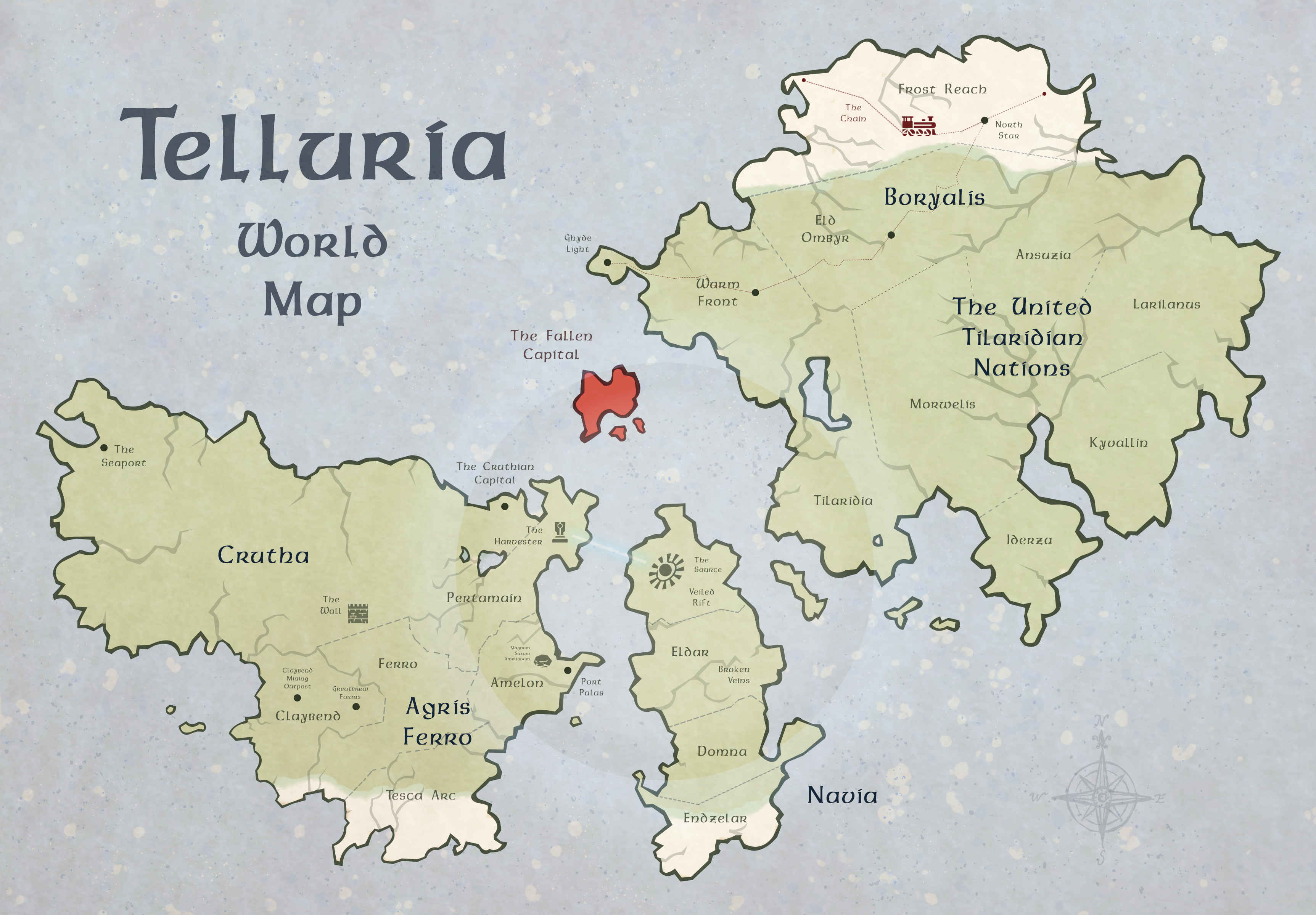Telluria
The realm of Telluria is a collaboratively-created storyworld comprised of five Regions spread across three major continents:
These Regions were developed by independent student groups of 3-4 organized around a shared storyworld framework: Name: Telluria
Aesthetic: Studio Ghibli / Avatar: The Last Airbender
Government Presence: ~ (Regional)
Rule of Law: ~ (Regional)
Social Services: ~ (Regional)
Economic Strength: 3 (Stable)
Wealth Distribution: 2 (Trending Up)
Agriculture & Trade: 1 (Trending Up)
Race Relations: 2 (Stable)
Class Relations: 2 (Stable)
Gender Relations: ~ (Regional)
Sexual Orientation Relations: ~ (Regional)
Military Influence: ~ (Regional)
Religious Influence: ~ (Regional)
Magick Influence: 2 (Trending Up)
Technology Influence: 4 (Trending Down)
Arts & Culture Influence: ~ Governance: Decades of pestilence (commonly referred to as the Bloody Boils) have rendered the world a bleak wasteland. The global government, a democracy composed of parliament, executive, and judicial branches (with roles filled by elected regional representatives) is fractured; regional governments (with varying levels of competence and functionality) have emerged amid the chaos. Availability of social services is region-dependent, and the Rule of Law is not equally applied. Lack of legal oversight and pervasiveness of corruption have led to rampant distrust between regions, even as the world has begun to heal. Economy: There is substantial economic value to be gleaned from the re-emergence of magick, particularly in geographic areas near the Source. However, the Bloody Boils left a devastating scar on previously favorable trade conditions and coalitions. Decades of uneven application of law across regions, coupled with pervasive corruption, has resulted in the stagnation and collapse of global commerce. Yet, as the world reopens borders, downward trends in Agriculture & Trade as well as Wealth Distribution may be reversible. Social Relations: The world does not suffer from long-standing gender or sexual orientation discrimination, but Class Relations and Racial Relations dramatically deteriorated throughout the Great Pestilence and resulting economic collapse. Those who have seen their share of the pie chipped away are reaching a breaking point, evidenced in increased tension between the upper and lower classes of society. Cultural Influences: Traditional arts (performance, painting, sculpture, etc.) are region-specific. As the economy gradually collapsed, communities migrated toward the most lucrative forms of work within their region, specializing in different types of and approaches to Technology development. Divergence in technology literacy and proficiency across regions contributed to rising economic inequality. Due to increasing social tensions, ideologically divergent groups have expanded, with artisan, political, mercantile, scientific, religious, and other leaders tapping the Source to advance/evolve their tools, technologies, militaries, cultures, and other facets of society.
Navia, epicenter of The Source
The United Tilaridian Nations, the military nonpareil
Agris Ferro, the mining collective
Boryalis, the mysterious north
Crutha, the desert dystopia
These Regions were developed by independent student groups of 3-4 organized around a shared storyworld framework: Name: Telluria
Aesthetic: Studio Ghibli / Avatar: The Last Airbender
Government Presence: ~ (Regional)
Rule of Law: ~ (Regional)
Social Services: ~ (Regional)
Economic Strength: 3 (Stable)
Wealth Distribution: 2 (Trending Up)
Agriculture & Trade: 1 (Trending Up)
Race Relations: 2 (Stable)
Class Relations: 2 (Stable)
Gender Relations: ~ (Regional)
Sexual Orientation Relations: ~ (Regional)
Military Influence: ~ (Regional)
Religious Influence: ~ (Regional)
Magick Influence: 2 (Trending Up)
Technology Influence: 4 (Trending Down)
Arts & Culture Influence: ~ Governance: Decades of pestilence (commonly referred to as the Bloody Boils) have rendered the world a bleak wasteland. The global government, a democracy composed of parliament, executive, and judicial branches (with roles filled by elected regional representatives) is fractured; regional governments (with varying levels of competence and functionality) have emerged amid the chaos. Availability of social services is region-dependent, and the Rule of Law is not equally applied. Lack of legal oversight and pervasiveness of corruption have led to rampant distrust between regions, even as the world has begun to heal. Economy: There is substantial economic value to be gleaned from the re-emergence of magick, particularly in geographic areas near the Source. However, the Bloody Boils left a devastating scar on previously favorable trade conditions and coalitions. Decades of uneven application of law across regions, coupled with pervasive corruption, has resulted in the stagnation and collapse of global commerce. Yet, as the world reopens borders, downward trends in Agriculture & Trade as well as Wealth Distribution may be reversible. Social Relations: The world does not suffer from long-standing gender or sexual orientation discrimination, but Class Relations and Racial Relations dramatically deteriorated throughout the Great Pestilence and resulting economic collapse. Those who have seen their share of the pie chipped away are reaching a breaking point, evidenced in increased tension between the upper and lower classes of society. Cultural Influences: Traditional arts (performance, painting, sculpture, etc.) are region-specific. As the economy gradually collapsed, communities migrated toward the most lucrative forms of work within their region, specializing in different types of and approaches to Technology development. Divergence in technology literacy and proficiency across regions contributed to rising economic inequality. Due to increasing social tensions, ideologically divergent groups have expanded, with artisan, political, mercantile, scientific, religious, and other leaders tapping the Source to advance/evolve their tools, technologies, militaries, cultures, and other facets of society.
Type
Planet


Comments